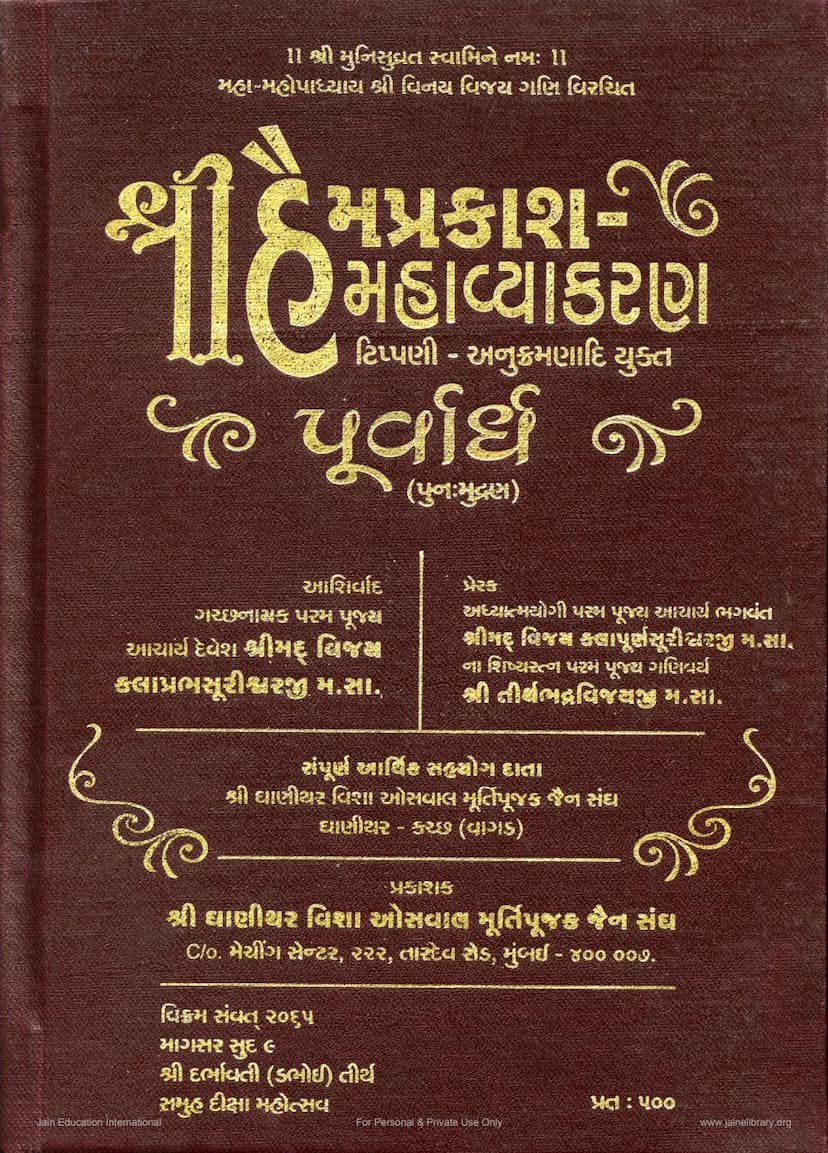Haim Prakash Maha Vyakaranam Purvarddham
Added to library: September 1, 2025

Summary
Based on the provided text, here is a comprehensive summary in English of the Jain text "Haim Prakash Maha Vyakaranam Purvarddham" by Kshamavijay, focusing on the core content and purpose of the book as revealed in the excerpts:
Book Title: Haim Prakash Maha Vyakaranam Purvarddham (Golden Light Great Grammar - Part One) Author: Mahamahopadhyaya Shri Vinaya Vijaya Gani Editor: Upadhyaya Kshama Vijaya Gani Publisher: Shah Hiralal Somchand, Kot, Mumbai (for the reprint), originally published by Shah Hiralal Somchand, Bombay in Vikram Samvat 1994 (1937 CE). Catalog Link: https://jainqq.org/explore/004040/1
Overall Purpose and Context:
"Haim Prakash Maha Vyakaranam Purvarddham" is a significant commentary and elaboration on the foundational Sanskrit grammar text, the "Siddha Hem Shabdanushasana," composed by the renowned Jain Acharya Hemachandra Suri. Mahamahopadhyaya Shri Vinaya Vijaya Gani, a highly learned scholar, created "Haim Prakash" with the express intention of making the study of Sanskrit grammar more accessible, systematic, and profound, particularly for Jain scholars and students aiming to understand Jinagam literature. The "Purvarddham" (Part One) covers the initial sections of this comprehensive grammatical work.
Key Features and Content (as indicated by the excerpts):
-
Commentary and Elaboration: The core of "Haim Prakash" is its detailed commentary on the sutras (aphorisms) of Hemachandra's "Siddha Hem Shabdanushasana." While it utilizes the original sutras, the author Vinaya Vijaya Gani has extensively elaborated on them, drawing from various grammatical traditions and providing extensive explanations (tīkā).
-
Systematic Approach (Prakriya): The text is structured according to the "Prakriya" (process or method) of Sanskrit grammar, which focuses on the practical application and formation of words and sentences. This approach is considered more accessible for learners than the "Ashṭādhyāyī" (chapter order) followed by Panini's grammar, which Vinaya Vijaya Gani found suitable for highly discerning minds but less so for students.
-
Emphasis on Jain Context: The book is deeply rooted in the Jain tradition. Its study is presented as essential for understanding Jain Agamas and achieving spiritual liberation (moksha). The introductory materials and acknowledgments highlight the blessings and support received from prominent Jain Acharyas and Sanghas, emphasizing its religious significance.
-
Comprehensive Coverage (Prakriya Ram): The "Prakriya Ram" section, as detailed in the editor's and publisher's forewords, covers foundational aspects of Sanskrit grammar. This includes:
- Sanjna Adhikara (Chapter on Nouns/Terms): This initial part introduces essential grammatical terms and classifications, such as vowels (svars), consonants (vyanjana), their phonetic properties (sthanas, prayatnas), phonetic rules (sandhi), and specific categories like 'it' (vowel or consonant that is elided). The detailed "Sutra Anukramanika" (index of sutras) provided at the end confirms the extensive coverage of various grammatical concepts.
- Sandhi (Euphonic Combination): The text systematically explains the rules of sandhi, covering vowel sandhis (svara sandhi) and consonant sandhis (vyanjana sandhi), including specific rules for combinations involving vowels (like 'a', 'i', 'u', 'ṛ', 'l') and consonants (like the application of 'jhal' and 's' to 'k', 't', 'p', etc.).
- Karakas (Thematic Roles/Cases): A significant portion of the Purvarddham is dedicated to the Karaka system, which explains how nouns relate to the verb in a sentence. It delves into the various karakas like Kartr (agent), Karma (object), Karana (instrument), Sampradana (recipient/dative), Apadana (ablative), Sambandha (genitive), and Adhikaraṇa (locative), providing detailed rules and examples from classical Sanskrit literature and usage.
- Nouns (Nāma) and Feminine Suffixes (Strīpratyaya): The text explains how feminine nouns are formed from masculine or neuter stems, covering common suffixes and rules governing their application.
- Avyayas (Indeclinables): The grammar covers indeclinable words, which are crucial for understanding sentence structure and meaning, explaining their usage and various categories.
- Usage of "Yuṣmad" and "Asmad" (Pronouns): The text also details the declension and usage of the personal pronouns "you" (yuṣmad) and "I" (asmad).
-
Editorial Excellence: The re-publication highlights the meticulous editing work of Upadhyaya Kshama Vijaya Gani, who is praised for his profound knowledge, eloquence, and character. The editor's dedication to compiling and editing this previously unpublished work, even while unwell, is a testament to his commitment to preserving and disseminating valuable knowledge.
-
Scholarly Lineage: The book's origin and its commentary reflect a rich scholarly lineage within Jainism, tracing back to Acharya Hemachandra Suri and further through the line of teachers like Mahamahopadhyaya Vinaya Vijaya Gani and his guru, Mahamahopadhyaya Soma Vijaya Gani, and ultimately to the editor Upadhyaya Kshama Vijaya Gani, who was a disciple of Muni Shri Amivijaya Maharaj.
-
Linguistic Rigor: The excerpts showcase a deep understanding of Sanskrit grammar, including complex rules of sandhi, case-endings (vibhakti), and the philosophical underpinnings of language, as discussed in the sections on "Nyayas" (logical maxims) applied to grammar. The inclusion of extensive "Anukramanika" (indices) for sutras and topics further illustrates the book's thoroughness.
-
Historical Significance: The introduction of the reprint mentions the original publication in 1937 CE and the effort to preserve and re-publish the text, suggesting its long-standing value and the need to make it available to new generations of scholars.
In essence, "Haim Prakash Maha Vyakaranam Purvarddham" is a vital contribution to Sanskrit grammar studies, serving as a meticulously crafted guide for understanding the intricacies of the language based on the venerable tradition of Acharya Hemachandra Suri, enriched by the scholarly insights of Mahamahopadhyaya Vinaya Vijaya Gani and diligently edited by Upadhyaya Kshama Vijaya Gani.